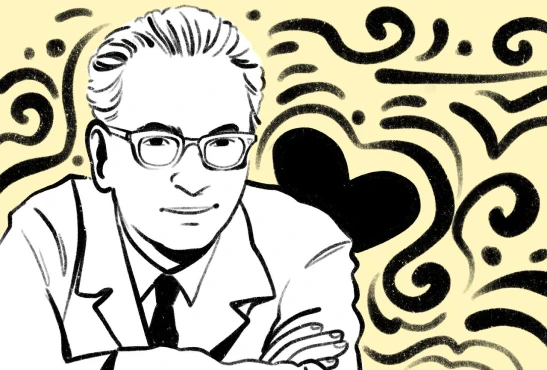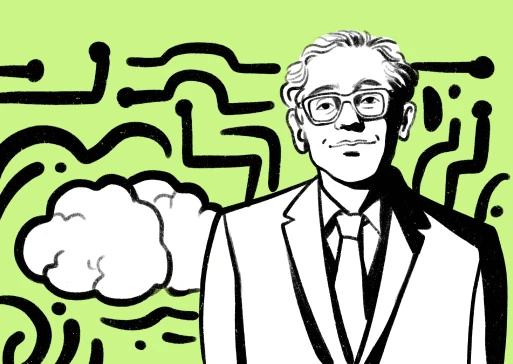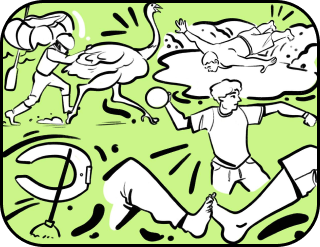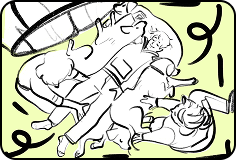How to prevent the brain from making choices
The professor entered the lecture hall with determination. Approaching the podium, he gave a meaningful look at the young students, who had fallen silent at his presence, then smirked and asked, “Do you think humans possess free will, or is everything decided for them? Who makes the choices: the individual or the universal mind?”
The students began to murmur, the room buzzed with excitement as doubts mingled with what seemed obvious, but no one could provide a definitive answer: some shouted that humans live according to a predetermined script, and the director is not the person themselves, but their brain. Others argued that the brain is merely an instrument of the will and, therefore, plays no independent role.
The professor then suggested that the students divide into two groups and conduct research, providing scientific justification for their conclusions. One group, codenamed “Brain,” was tasked with finding evidence that decisions are made by something or someone beyond the control of human consciousness. The other group, “Soul,” was to find proof that the choice is always in the hands of the individual, and no one can influence it.
We also gave you a choice – what to read first: a life decision or a technical one. So, choose with your soul. Or your brain. Or, we don’t even know anymore.
The first group of students reasoned as follows:
One can contemplate the ability to choose and the freedom within it for a long time. Various arguments and experimental results can be presented both in favor of and against this idea. However, if we turn to history and look at real human lives, we can see how a person, armed only with faith and purpose, makes a choice through their own will to survive where it seems impossible. Such people, by their vivid example, demonstrate how the choice in favor of life helped them overcome unimaginable obstacles and survive.
Perhaps the most striking “evidence” of free will is Viktor Frankl – a talented Austrian psychiatrist who saved tens of thousands of people not only in peacetime but also in the inhumane conditions of concentration camps.
He managed not only to survive in a place where it seemed impossible, but also to help others avoid despair, find strength, and discover the meaning of life to endure until liberation. To this day, Viktor Frankl remains a model of an extraordinary will to live at any cost. What drove him? And was the outcome predetermined?
Viktor Frankl was born on March 26, 1905, in Vienna. At just 4 years old, Viktor already knew that he wanted to become a doctor. During his school years, Viktor Frankl wrote a treatise titled “The Psychology of Philosophical Thought.” As a young man, he graduated from the medical faculty of the University of Vienna, choosing neurology and psychiatry as his specialization.
Almost immediately after graduating, Viktor Frankl developed his own direction in psychotherapy – logotherapy – healing through meaning. Logotherapy was designed to help people who were depressed or on the verge of suicide.
In 1938, when the Nazis came to power, Viktor was forbidden from treating Aryan patients. He then went to work as a neurosurgeon at the Rothschild Hospital, where he headed the neurology department and treated Jewish patients exclusively.
In 1941, Viktor Frankl married a nurse named Tilly Grosser. Despite the difficult times, he did not lose heart and continued to live as fully as possible: he worked, built a family, and even prepared his first book, The Doctor and the Soul, for publication.
In September 1942, Viktor Frankl, his young wife, and his parents were sent to a concentration camp. One might expect that despair would take over, but Viktor remained true to his life views and profession. In the camp, he provided psychological help to arriving prisoners, assisting them in overcoming the initial shock and offering support during the early stages.
“We had to awaken the will to live, the will to continue existing, to survive the imprisonment. But in every case, the courage to live or the weariness of life depended solely on whether the person had faith in the meaning of life, in the meaning of their own life. The motto of all the psychotherapeutic work carried out in the concentration camp could be summed up by Nietzsche’s words: ‘He who has a why to live can bear almost any how.” — Viktor Frankl
Frankl and his colleagues did everything they could to help people overcome despair and maintain their will to live. He gave lectures and shared methods of psychological self-help. In moments when he found it particularly difficult, Viktor imagined himself standing at a lectern in a large, beautiful, warm, and well-lit lecture hall in front of an engaged audience, delivering a lecture on the topic “Group Psychotherapy Experiences in a Concentration Camp” and talking about everything he had been through. The hope and belief that this would one day happen gave him the strength and desire to live.
Two years later, in 1944, he was transferred to Auschwitz, and then to the Türkheim camp. There, Viktor Frankl worked as a laborer and was liberated at the end of April 1945.
Another meaning of life for him was his dream of being reunited with his beloved wife. He imagined embracing her after their long separation, feeling the warmth of her touch.
Upon returning home, he learned that his wife, parents, and most of his friends had perished in the camps. Once again, life lost its meaning, and the question arose: how to go on living after such devastating losses?
Back in Vienna, at the insistence and with the support of his friends, Viktor wrote a book that became not only a revelation but also a healing for his wounded soul. The book Man’s Search for Meaning helped not only him but also thousands of others survive after the concentration camps. Viktor Frankl passed away at the age of 92 from heart failure. But his books, which he managed to write and publish, live on.
Viktor believed that spirituality and reason are the primary traits of a human being. He focused on the key differences between humans and animals. Viktor Frankl was convinced that people are driven by something greater than merely the desire to satisfy their biological needs or to achieve success in society. A person needs a meaning in life, and this was the essence of the concept of logotherapy. His approach underwent the most brutal test in the concentration camp. By following it, Viktor Frankl not only preserved his own humanity but also saved thousands of other lives. Frankl believed that the meaning of life cannot be invented – it can only be discovered or realized.
“The uniqueness inherent in every person determines the meaning of each individual life. Each person is unique, and so is what they alone can and must do – in their work, in their creativity, in their love. The realization of such irreplaceability creates a sense of responsibility for one’s own life, for living it to the fullest, for illuminating it in all its entirety. A person who has recognized their responsibility to another person or to a task entrusted specifically to them will never abandon life. They know why they exist, and therefore will find the strength to endure almost any how.” — Viktor Frankl, Man’s Search for Meaning
If we are to discuss the scientific basis for the idea that choices are made not by the brain but by the will of the soul, we can refer to studies conducted to refute Benjamin Libet’s experiment, which claimed that humans do not have free will and that their entire life is controlled by something beyond their power.
In 2009, scientists from the University of Otago tested Libet’s theory by slightly modifying the experiment. In their version, participants were required to respond to an auditory signal and then make a choice: to press a key or not. It turned out that the action or lack thereof did not matter – the readiness potential arose in any case.
Readiness potential refers to the ability of a person to be prepared to follow or not follow what the brain impulse suggests.
The same was found in a 2016 study: strong readiness potential does not necessarily result in movement. Moreover, after the readiness potential arises, a person can stop and choose not to move. If there is a readiness potential but no action, it means that the person is deciding whether or not to press the button. The readiness to act and the action itself may not be connected at all.
So what does this brain activity signify?
French researcher Aaron Schurger proposed a theory that readiness potential is simply the accumulation of neural noise, random electrical fluctuations in neural networks.
Prescott Alexander from Dartmouth College suggested that this brain activity reflects a general anticipation – the awareness that an event is about to happen.
Eric Emmons from the Department of Neurology at the University of Iowa linked readiness potential with the sense of time. The scientist suggested that this is how our brain encodes its own time intervals.
“The research data and real-life stories support the theory of free will and the existence of human volition. There is something more to a person than just the influence of brain impulses. We don’t know where a particular desire originates in the mind, but we do know for sure that a person is capable of making a choice to either act or, on the contrary, to stop and do things their own way,” concluded the students from the first group, ‘Soul’.

The second group of students recalled the famous Benjamin Libet Experiment, and here’s why:
Once, a simple experiment turned all the existing knowledge of modern science about humans upside down. In 1983, physiologist Benjamin Libet made a discovery that cast doubt on the concept of free will, handing power over to the brain.
While working in the neurosurgery department of a hospital in San Francisco, the young and ambitious scientist Benjamin Libet gained access to the human brain. And he did so with a purpose. The fact is that neurosurgical operations are a perfect opportunity to conduct experiments on an open brain.
Brain surgeries are performed without general anesthesia. There are no pain receptors in the brain, so anesthesia, except for a local anesthetic like Novocaine for the scalp, is not needed. It is also crucial for the patient to remain conscious so that the surgeon can monitor the patient’s condition when stimulating different parts of the brain. It was during these neurosurgical operations and the experiments conducted at such times that the brain was revealed to us, both literally and figuratively.
This is how Benjamin Libet gained access to a living human brain. By applying electrodes, he measured the reaction speed, trying to understand how much time passed between an electrical impulse and the corresponding muscle contraction in the patient’s body. And then something surprising was discovered – the delay between the impulse and the movement was slightly more than half a second, which is a significant interval. This led to the question: where is the person’s consciousness during this time?
Driven by this question, Libet designed a special machine, where one sensor was connected to the subject’s head through a helmet with electrodes, and another was attached to the wrist.
The participant in the experiment was required to watch a large white dial with a green dot moving around it. Libet was to record the exact moment when the participant consciously decided to move their hand.
As a result, Libet obtained three measurements:
- The time when the person decided to move their hand – the green dot.
- The time when the brain became activated to move the hand – the impulse to the helmet.
- The time when the hand actually moved – the sensor on the wrist.
If you think logically, the sequence of actions should be as follows: first, the person makes a conscious decision to move their hand, then their brain sends the corresponding command to the body, and only after that does the movement occur. However, Libet’s experiment showed that the brain makes the decision before our consciousness does.
When the brain has already decided to move the hand, the consciousness is still unaware of it. After the half-second delay, our consciousness becomes aware that it should make the decision, and then, 0.2 seconds later, the sensor on the wrist reacts – the muscle contracts.
The conclusion was as follows: human behavior is not controlled by consciousness, as was previously believed, but by the brain. Moreover, it operates independently of consciousness.
Libet’s experiment demonstrated that we are not in control of our behavior. Theoretically, we have 0.2 seconds to stop an action initiated by our brain, but what is the likelihood that consciousness can alter this decision if it is delayed by those same 0.5 seconds?
Libet’s experiment was not the only one; it merely sparked a powerful push toward future scientific revolutions. Many experiments have since been conducted, by both supporters and opponents of the theory.
One of the latest studies on this topic, conducted using functional magnetic resonance imaging (fMRI) at the Max Planck Institute for Human Cognitive and Brain Sciences in Leipzig, showed that by registering brain activity, we can predict what a person will think about in seven seconds. More precisely, we can determine what the brain has already decided before the person is consciously aware of it.
“The conclusion seems to be,” the students from the “Brain” group concluded, “that all our meanings are governed by our brain, not by consciousness. We are sure to get a high score.”
It looks like the professor is in for a challenging week.

The micro world makes particles dance to the melody of probability.
Thank you!




